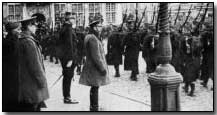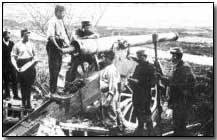Battles - The Battle of the Yser, 1914
 The Belgian army's defence of the Yser Canal in October
1914 is referred to as the Battle of Yser. The German offensive at the
Canal, which ran south from the English Channel at Nieuwpoort in
north-western Belgium, formed part of a wider battle for control of
Flanders, notably at Ypres.
The Belgian army's defence of the Yser Canal in October
1914 is referred to as the Battle of Yser. The German offensive at the
Canal, which ran south from the English Channel at Nieuwpoort in
north-western Belgium, formed part of a wider battle for control of
Flanders, notably at Ypres.
The land surrounding the River Yser, which formed a natural obstacle to the German advance, was woven through with a network of drainage canals, the area itself being made up of 'polder', or reclaimed land. The water level was situated just below the surface and was regulated by the canals and their associated network of sluices and pumps. The head of the drainage system was at Nieuwpoort, where the Yser met the sea, and where several other major canals joined.
The German Fourth Army, operating under Duke Albrecht, began attacking Belgian forces deployed along the Canal on 18 October with a heavy bombardment all along the Belgian lines. With the aid of British warships lying off the coast the Belgians managed to repel the German advance, the latter temporarily withdrawing to Oostende, having unsuccessfully trying to torpedo the warships.
 Following
repeated attacks over the following four days, a German division managed to
form a bridgehead at Tervaete after a small band of troops managed to
quietly cross a temporary footbridge over the Canal on 22 October without
having fired a shot. This success forced the Belgians to retreat to the
Diksmuide-Nieuwpoort railway on 24 October. Whilst there they received
reinforcements from the French 42nd division.
Following
repeated attacks over the following four days, a German division managed to
form a bridgehead at Tervaete after a small band of troops managed to
quietly cross a temporary footbridge over the Canal on 22 October without
having fired a shot. This success forced the Belgians to retreat to the
Diksmuide-Nieuwpoort railway on 24 October. Whilst there they received
reinforcements from the French 42nd division.
At Diksmuide itself, twelve miles south of Nieuwpoort, half of the 6,500 French navy troops, the Marins Fusiliers, stationed under the command of Admiral Ronarc'h, suffered casualties or losses. Since Diksmuide formed a bridgehead to the eastern side of the canal its retention was of great importance.
With Belgian resistance weakening and the King, Albert I, fearing a German breakthrough in the direction of Dunkirk and Calais, the Belgians took the drastic step of opening of the Canal locks at Nieuwpoort on 25 October. The result was a gradual flooding of the low country between the Canal and the railway. Consequently the German Fourth Army was obliged to retreat on 29 October, transferring its offensive effort to Ypres.
Diksmuide fell to the Germans on 10 November, but Nieuwpoort remained in Belgian hands throughout the war.
Click here to view a map of the German retreat following the Marne battle and the subsequent race to the sea.
Photographs courtesy of Photos of the Great War website
Feature: Brave Little Belgium - The Battle of Yser
Primary Documents: The Flooding of the Yser by the Belgian Minister of Justice
"Drum Fire" was an artillery barrage fired not in salvo but by each gun in succession.
- Did you know?
